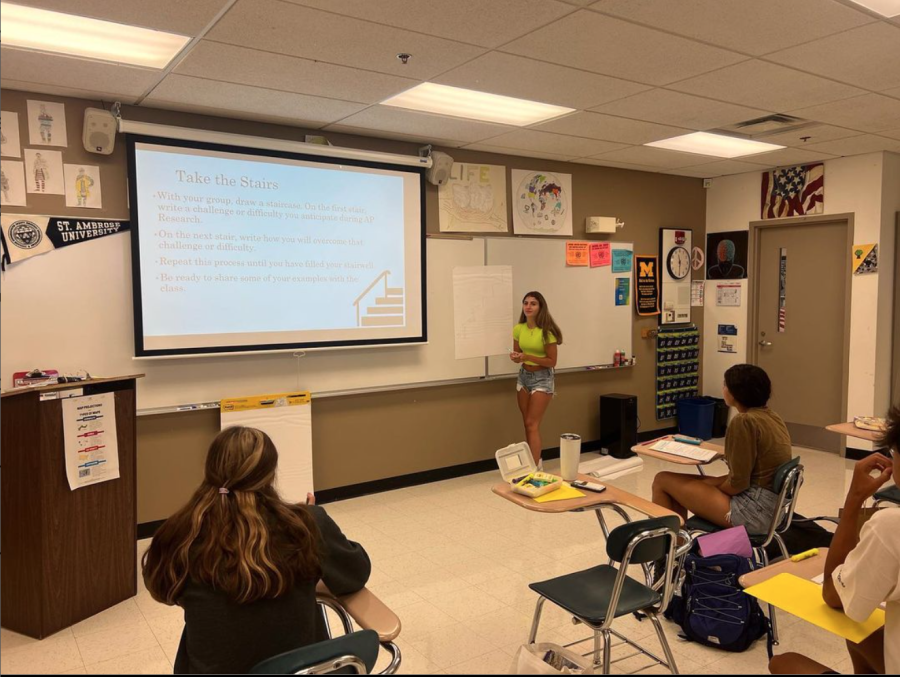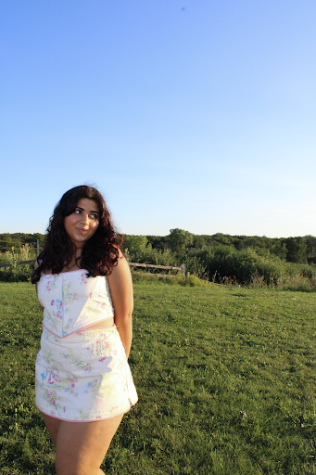Inside AP Research
AP Research’s first day of class, outlining challenges of research.
November 30, 2022
AP Research, a class of only four, is one of the most intensive classes offered. Principal Dr. Erin Lenart calls it the “highest level of research you can accomplish in high school,” yet the class is unknown to many.
In AP Research, students are tasked to a year-long independent research project. This includes conducting a study that has not been done before, collecting and analyzing data, writing a 4,000-5,000 word-long research paper, and presenting your findings to an audience.
Because students have the chance to conduct their own research, the class is uniquely structured compared to traditional curriculums. “Other classes are content driven classes, but [in AP Research] the content is truly driven by the students,” said Lenart.
Although AP Research is considered a social studies class, students can earn course credit in any discipline depending on their focus of research — students ultimately create their own curriculum by pursuing a topic they’re passionate about.
Compelled by her own experiences in the classroom, junior Bianca Storino decided to research how teachers’ voices impact student engagement.
Storino is particularly looking at volume and pitch as she believes “voice and tone have such an impact on the way students perceive and understand lessons.”
To conduct her study, she’ll have students rank the engagement of foreign language teachers in a language where the student can’t understand in order to eliminate bias.
Similar to Storino, junior Ana Dollard found her topic from her own experiences — she’s researching social media use and its relation to the wellbeing of adolescents by surveying students.
As technology has increased social media use among teenagers, Dollard is interested in a psychological perspective. She is specifically looking at how social media interaction impacts loneliness, and hopes her study “can help people find ways to use social media that aren’t harmful to their psychological state.”
Dollard enjoys the one-of-a-kind nature of AP Research, calling it “one of the most academically stimulating classes [she’s] ever taken.”
Despite her engagement in the class, feasibility poses a challenge for her study.
“At every twist and turn, there’s another roadblock with figuring out how my methodology will be shaped,” she said.
Other uncommon features of AP Research among the meticulous requirements and small class size is the teaching design; there is no answer key or anyone to correct your work. Both Social Studies Instructional Director Mr. Stephen Dunn and Lenart co-teach the class, however, they’re not allowed to specifically answer questions, which helps make the class 100% student-directed.
Despite that this marks Lenart’s first year teaching the course, she has experience in research, which motivated her to get involved in teaching students taking AP Research. In graduate school, Lenart wrote her own dissertation about school improvement planning and eliminating barriers in student learning.
AP Research students can choose to research almost anything, as long as it hasn’t been done before. A requirement of the College Board, a gap is an unexplored area in a specific topic that limits a conclusion for a given research question.
Finding a gap in research is essential to the success of the study, but also one of the most challenging components of the class.
Junior Amani Yousuf switched gears from planning on originally studying reservation schools to instead focus on mental health among Native Americans through semi-structured interviews (a method that utilizes open-ended and follow-up questions).
Specifically, Yousuf is researching the impact of a Talking Circle, an Indigenous healing method, on the Oneida Nation of Wisconsin, which she described as “an under-researched phenomenon.” By doing so, she is filling the gap in research surrounding Indigenous Talking Circles, uncovering new knowledge and answering her research question.
Another part of the research process is a hypothesis, an assumption made about the results of a study.
Junior Daniel Lim aims to research medical students and their ability to cope with burnout and anxiety through a semi-structured survey and a mixed method. He hypothesizes his research will represent “a large number of students who cannot cope with workload, and a slightly larger group who can.”
However, bias is a further difficulty in research as students must remain neutral throughout the whole study.
“I should prepare myself for extreme results, as I should not be biased to the outcome of my research,” said Lim.
As students conduct their own research, they also gain skills such as confidence, critical thinking, and adaptability. Dunn and Lenart compare these traits to those found in the district’s Portrait of a Learner, an improvement plan which they are both involved in.
In a class filled with curiosity, creativity, and only four students, many new concepts and theories can be brought to fruition by the researchers’ hard work and dedication.
“While this has been no easy task, it’s also been a very rewarding and enlightening experience honoring the people I’m studying,” said Yousuf.








Vicky Kujawa • Dec 12, 2022 at 2:37 pm
Just curious; what are the topics of the research for the 2022 academic school year for the AP course? I would be very interested to know; please share!
Ana • Dec 2, 2022 at 7:38 pm
Great article, Alia! You have a beautiful writing style.